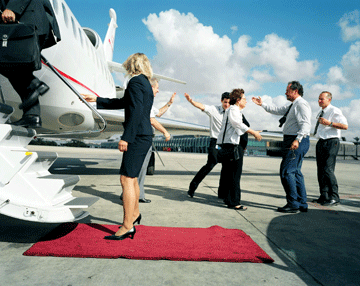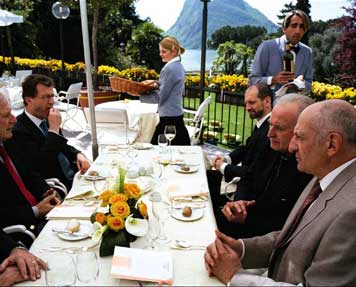POLITICAL THEATER: PROTOKOLL BY CHRISTIAN LUTZ
Over the course of three years, Geneva based photographer, Christian Lutz travelled with the Swiss diplomatic corp in an official capacity. His own ambiguous relationship to power (“part attraction, part repulsion”) reflected through the camera lens captured a dimension of diplomacy he calls “political theater”. The result is PROTOKOLL, a handsome pictorial study of authority, power and hierarchal systems…
You’re not digital. The pictures in this book were shot on film…
Yes, this is still an analog operation, because of the plasticity of the form. I use a medium format negative in order to get more detail and scale to reality. Digital has much less detail, but the medium format camera and film are able to express more: details like skin, emotions— it has everything to do with decoration and theater…
From what I’ve seen so far, there are a lot of unguarded moments in this book. It’s almost as though the subjects are unaware there is a photographer in the room, yet these are pretty public situations. What is that about?
It’s a skill I’ve developed over 10 years of photography. I’m pretty good with people—wherever they’re come from, whoever they are, whatever their function might be, I’m always good at dealing with human beings. So I was able to gain the trust of most of these characters —and express my own perspective in the frame.
Of course, like many photographers who work very fast—you become invisible, you cheat a little bit—there’s no general rule. Sometimes I’m upfront, I introduce myself—they know me and then there is a real relationship between them and the photographic act… and other times I cheat, pretending to photograph something else, then suddenly frame them. It has to do with reportage photography, you utilize your personality and throw in a few tricks. Photography can be very fast–sometimes people don’t always understand what you’re doing.
You mentioned a troubled relationship to Power.
Like many people, there are things in society that I simply don’t accept. I don’t understand why things are a certain way. I always try to use photography if not to accept, but to understand this. I force myself to confront certain realities through photography—and then maybe by working through the subject matter and being able to express myself and critique the situation, I can accept it.
There’s a lot of superficiality in politics and I struggle with it.
What sort of feedback have you received from your subjects, the politicians in this book?
Photography is very subjective so sometimes I have a picture I’ve invested with a strong sense of direction and rhythm— and the same picture can be read completely differently by someone else. Of course I play a bit with this. Many politicians in Switzerland are bourgeois and often feel like they have achieved something when they are portrayed in these settings of luxury and prestige. I might be poking fun at them, but they read it differently.
On the other hand, there are more astute politicians who understand my goal and intentions—but they also consider politics a kind of theater, so they enjoy seeing themselves as “players” on this stage—and if this is captured by photography with a sense of fun and intensity—it’s easy for them to accept it.
Where there any striking moments?
There was a very vivid incident which I did not expect at all, they were fifteen journeys abroad and I was very excited about confronting different cultures—but then the president of India came to Switzerland and I was very very surprised by all the layers of hierarchies within hierarchies within the protocol of the Indian delegation— while they were operating in Switzerland. It was a combination of rank and caste systems. It was actually the toughest assignment, over the two-day visit we were incredibly busy.
Were there ever surprises in the final print? Was there ever something different from what you thought you framed?
When you receive the contact sheet, then actually you’re surprised by perfect graphic aspects of your picture—it’s never like ‘oh, something happened there, I didn’t notice it while I was shooting…’
When I work on a story its very directed, I don’t shoot all day long, I just focus on highlights— when you can feel a sort of energy — that’s when I work. So nothing really happens that I did not notice… But then on the contact sheet when the film is developed, you discover the ‘perfect instance’. It’s like a dance or theater—suddenly there’s magic going on, there’s a real dialogue between the people, the light arrives, as they say in latin ‘decorum’ —the foreground and the background come together and the magic just appears—and this is the surprise, the ‘perfect instance’.
The picture where they are boarding the plane for instance, it took a whole roll of film— 24 shots over two or three minutes because I could feel something going on: I remember the carpet, the stewardess, the guy boarding the plane and I remember noting all this protocol between the ambassador and the driver and the copilot, the pilot, the ambassador’s assistant. There was a sort of energy going on… On the contact sheet it suddenly it was all there and it was like ‘wow’ and a perfect picture appears.
Elsewhere you made an observation about the diplomatic bubble during your journeys abroad. Are diplomats everywhere the same?
At least Swiss diplomats, wherever they are, behave in the same way. It was never a surprise to arrive in say the airport at Shanghai or Tel-Aviv and okay the driver might be Israeli or he might be Chinese, but what you’re going to hear, is the same tension because the fact is every one has a role to perform and live up to —everyone reports to superiors—so that every trip becomes exactly the same trip. The fifteen trips I made were exactly the same one : a temple in Tibet, or a monastery in Bulgaria, the way the visit was set up was exactly the same.
This is why I don’t mention the name of the ambassador or any of the politicians–what was important to me was the locations, because wherever you were, the exact same situation could unfold whether it was in Lhasa in front of a temple or in Rome in the former dictator’s building.
There is a lot of code and protocol when you’re in the diplomatic arena, this is actually their duty. If you have a career in diplomacy you can be kicked to Russia or Africa and you are always expected to conduct yourself in the same way with your staff. You deal differently with the local culture but when you’re going to welcome a minister— this was my main focus to observe their behavior with the minister, the exact same behavior wherever they are.
Your next project is about cowboys. How did you get from here to there?
There are two links between Protokoll and West.
I am very interested in human relationships and in Protokoll you can see this. Sometimes the people were transformed into puppets, they became very cold, but other times they were very close to expressing their humanity. I was interested in the wives of the ambassadors and the ministers—they were sometimes very human and this aspect of photography is very important to me. In West, I’m closer to this sort of expression—but in a very austere, difficult environment…
West is also about power relationships. These cowboys and farmers struggle to completely master the nature—the land and the animals— which surrounds them. It’s very similar to colonialism, they have a strong and violent relationship to the animals. But this story is also important to me because there is a lot of poetry to it. There are many beautiful moments: there is a great harmony and a sense of life, despite the very violent dynamic with nature. I have a strong emotional attachment to this, Protokoll was for more a cerebral exercise. West is from the heart.
Protokoll is published by Lars Muller Editions , Zurich. It is also available on Amazon.com (http://www.amazon.com/Protokoll-Christian-Lutz/dp/3037781106)
For more about Christian Lutz and his work visit http://strates.ch under photographers/geneva/Christian Lutz.





